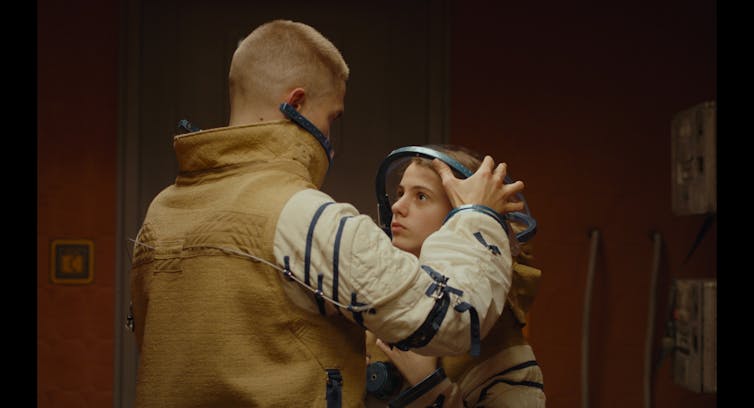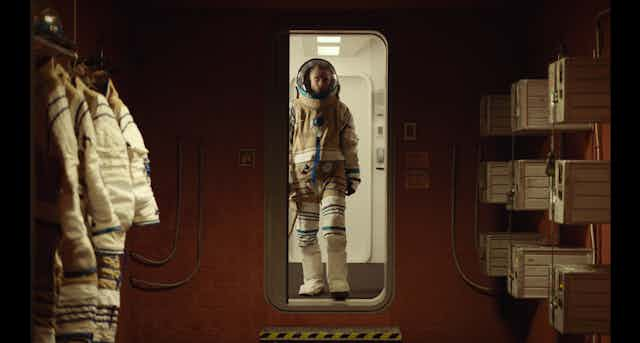It feels apt that Claire Denis’s new film, High Life is reportedly an idea she’d been toying with for 15 years. The movie is already drawing comparison to Solaris, a science fiction film by the seminal slow cinema director Andrei Tarkovsky.
Denis has dabbled with slow cinema aesthetics before. Her 2009 film White Material portrays a struggling female coffee producer who elects not to flee an impending civil war. The cinematography revels in stillness and quietude. Denis’s characters are developed through movement and actions more than dialogue. As the modern world becomes more and more fast paced, the idea of stillness is beginning to become a more desirable commodity.
Stillness is one of the hallmarks of slow cinema, along with the use of static shots, long duration shots, pans, tracking shots – as well as a narrative focus on the more mundane aspects of life. This aesthetic has garnered much praise and criticism. Paul Schrader, academic, screenwriter and director, drew attention to certain aspects of this aesthetic in his seminal book, Transcendental Style in Film.
The ideas raised here have since been applied to slow cinema. In recent years, the aesthetic was used frequently within the arthouse sector, garnering critical acclaim and academic interest. But Schrader has recently stated that he believes “slow cinema may be running its course”.
It’s getting closer and closer to the art gallery and museum. It had a real interesting moment in the last 10 years, but now the novelty has worn off, and people are not as mesmerised as they were when the slowness was really being used as a new concept of film time.
This is a bold statement about an aesthetic that has consistently created a polarising experience, finding its success primarily in the arthouse. Yet, the aesthetic seems to be breaking away from the arthouse sector, seeping into the mainstream in multiple areas, providing the audience with something they require.
Small moments savoured
At the 2019 Oscars, Roma won awards in the categories of best director, best foreign language film and best cinematography. This critically praised film clearly has slow cinema aesthetics running throughout it. There is a focus on the mundane – the small, seemingly insignificant moments in life. The opening sequence is a nine-minute shot of a women mopping the floor and walking through a house. It relies on the use of tracking shots and pans. Situations are frequently shown in long shot, allowing the audience to rove around the frame, not necessarily focusing on the protagonists.
Schrader would argue that Roma isn’t slow cinema – that it is still too focused on a narrative to be the purest form of the slow aesthetic. This is evident from the diagram Schrader created for a new edition of Transcendental Style in Film – the Tarkovsky Ring. The directors placed outside of the ring are the ones who create films that are least concerned with narrative as the driving force of the film.
Schrader’s damming opinion of them is that: “There’s not much I’m going to get from Wang Bing or Béla Tarr or Lav Diaz.” (Directors who revel in stillness from China, Hungary & the Philippines). Schrader’s opinion aligns with the mainstream film industry – that narrative is the driving force of film. Yet pleasure can be derived from a slow film in a different way if audiences are willing to consider the viewing practices of film in a different way.
Drinking alone, in your underwear
In recent years, European practices such as Hygge have become exceedingly popular. The lesser known Dutch gezellig (which roughly translates as cosiness, contentment or companionship) also received some attention. At the end of last year the Finnish kalsarikänni (drinking at home, alone, in underwear) was being considered as the next big phenomenon.
All of these lifestyle movements – and countless others – have one thing in common: escaping the frenetic pace of the modern world and relishing in the small things in life. It could be watching a candle flicker, cuddling in a blanket or just spending time with friends in your home. Escaping the noise of the modern world has been explored by Erling Kagge in his successful book, Silence: In the Age of Noise.

Apps such as Calm are finding popularity, allowing you to find tranquility for a few seconds within the day. Evidently there is a desire for stillness and silence, taking time to find the beauty in the normalcy of life. These desires can be fulfilled in the cinema, as long as audiences are willing to change their narrative expectations and see film in a different way.
Ben Rivers, a UK-based documentary and fiction filmmaker, and Anocha Suwichakornpong, a Thai independent filmmaker, two directors who favour slow cinema aesthetics, have crowdfunded their latest film In The Holocene. Roy Andersson has teased his new film at a recent Q & A, About Endlessness, which uses static compositions. Apichatpong Weerasethakul, a Thai independent filmmaker who has garnered interest on the film festival circuit with his slow cinema aesthetic, is shooting outside of Thailand for the first time, working with Tilda Swinton on his new film, Memoria. It could be that, despite Schrader’s views, 2019 is a bumper year for slow cinema.
Read more: Introducing 'lucid-dream cinema': movies to watch while you sleep
Schrader’s comments about slow cinema’s decline hold some sway, but only if you consider film purely as a narrative medium. Why can’t it also be something else? Slow cinema aesthetics are being adopted by more mainstream cinema, not just reserved for the arthouse or festival circuit.
People are searching for ways to escape the fast pace of the modern world and our constant connectivity. Why not find it by relishing the moments of stillness, the static shots of landscapes, the experience of ordinary people living ordinary lives, found in slow cinema.

